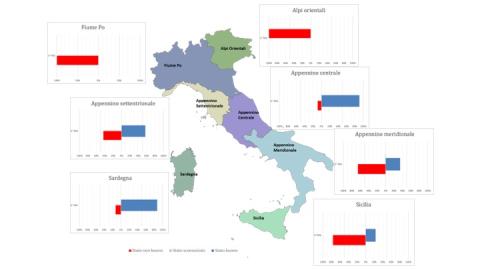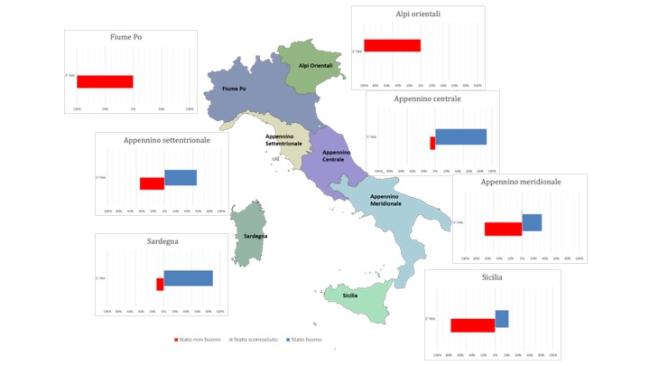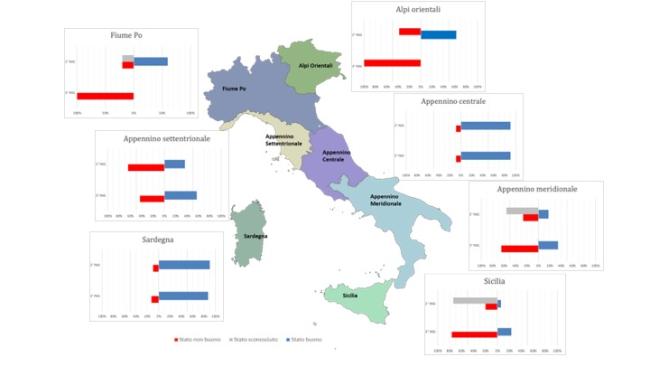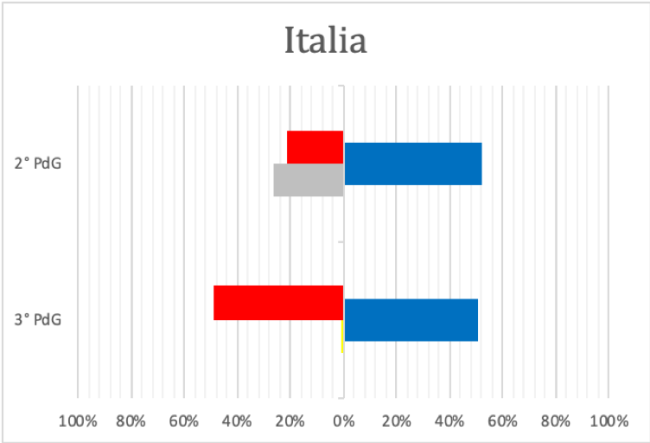Panel 1
Marina Penna
Coastal marine waters are “surface waters located inside an imaginary line, every point of which is one nautical mile seaward from the nearest point of the baseline used to determine the limit of territorial waters, and which may extend up to the outer limit of transitional waters” (Paragraph 1 of Article 74 of Legislative Decree 152/2006). The legislation (Legislative Decree 152/2006) mandates the achievement of a “good” status of water bodies (chemical + ecological) by the dates set by current legislation; failure to achieve environmental objectives results in the implementation of remediation measures. Based on the analysis of data reported by the Districts in the 3rd Reporting to the European Commission for the 2016–2021 six-year period (3rd RBMP), the chemical status of Italian coastal marine waters appears heterogeneous. This heterogeneity is evident both in terms of the number of water bodies identified per district and their classification. The Eastern Alps and Po River Districts have all water bodies in a “not good” chemical status, while in Sicily and the Southern Apennines District, over 60% of the water bodies are in a “not good” status. The Northern Apennines, Central Apennines, and Sardinia Districts, instead, register more than 50%, more than 90%, and more than 80%, respectively, in a “good” chemical status. At the national level, 51% of coastal marine water bodies are in good chemical status. Comparing the 2nd and 3rd RBMPs, in the 2nd RBMP, water bodies with unknown chemical status amounted to 26% (147 out of 561), whereas in the 3rd RBMP, only one water body has an unknown status. Generally, water bodies in good chemical status are comparable between the two RBMPs—52% and 51%, respectively—while water bodies in not good chemical status increased in the 3rd RBMP (49%).
The definition of the chemical status of coastal marine waters (good or not good) is based on the assessment of the presence of pollutants, to be detected in the water, sediments, or biota, identified as "priority" and "priority hazardous" substances, with their respective Environmental Quality Standards (EQS), which must not be exceeded in water bodies in order to classify them as having a “good” chemical status.
To verify, every six years, the effectiveness of the programs of measures implemented by the competent Authorities to reduce pressures, and thus the achievement of “good” status within the timeframes established by current legislation.
Directive 2000/60/EC
Directive 2013/39/EU (transposed by Legislative Decree 172/2015)
Law 221/2015
Legislative Decree 152/2006 and subsequent amendments
The legislation (Legislative Decree 152/2006) mandates the achievement of the “good” status of water bodies (ecological + chemical) by 2015 or, in the case of an extension, by 2027.
Panel 2
Legislative Decree 152/06 and implementing decrees transposing Directive 2000/60/EC
WISE Reporting of the 3rd Water Management Plan by River Basin Districts (updated October 2022)
With Decision EU 2020/21161, an update of substances, quality standards and analysis matrices was made
Data quality assessment
SNPA (Sistema Nazionale per la protezione dell’ambiente)
Extracted data Reporting WISE of the 3rd Water Water Management Plan of River Districts (October 2022 update)
National
2010-2015 2016-2021
Indicator assessment
The chemical status of transitional waters is based on the assessment of the presence of pollutants, to be detected in the water, sediments, or biota, identified as “priority” and “priority hazardous” substances with their respective Environmental Quality Standards (EQS), which must not be exceeded in the water bodies in order to classify them as having “good” chemical status. Chemical data from each station contribute to the overall chemical quality assessment of water bodies based on the principle of “one out, all out.”
Based on the analysis of data for the 2015–2021 period (updated October 2022), 51% of coastal marine water bodies are in good chemical status, not yet achieving the objective set by legislation. The Eastern Alps and Po River Districts have all water bodies in a not good chemical status (12 and 3 water bodies, respectively); also, Sicily and the Southern Apennines District show high percentages of water bodies in not good status, respectively over 70% and over 60%. In the Northern Apennines, Central Apennines, and Sardinia Districts, more than 50%, more than 90%, and more than 80% of water bodies, respectively, are in good chemical status (Figure 1).
The temporal coverage of the indicator does not currently allow for identifying a trend.
Data
Figure 3: National Chemical State of Coastal Marine Water Bodies- Comparison 2nd Cycle (2015-2021) and 3rd Cycle (2021-2027) of Water Management Plans
ISPRA processing on WISE 2022 reporting data (October 2022 update)
PdG - Management Plan; the colors determine the quality status as follows: Blue = High, Green = Good, Yellow = Enough, Orange = Poor, Red =Bad. Gray color identifies unclassified water bodies.




With Law 221/2015, the boundaries of the River Basin Districts were redefined; therefore, in order to compare the 2nd and 3rd RBMP cycles, the water bodies from the 2nd cycle were reassigned to the Districts according to the new delineation. This comparison shows that in the 2nd RBMP, water bodies with unknown chemical status were 26% (147 out of 561 total), while in the 3rd RBMP, only one water body was in an unknown status. Overall, in the 2nd and 3rd RBMPs, water bodies in good chemical status were comparable—52% and 51%, respectively. However, water bodies in not good chemical status increased in the 3rd RBMP, reaching 49%. Regarding the comparison between Districts, in the Eastern Alps and Po River Districts, the chemical status dropped from 38% (9 out of 24) and 20% (1 out of 3), respectively, of water bodies in good status, to 100% in not good status (12 and 3 water bodies, respectively). For the Sicily and Southern Apennines Districts, which in the 2nd RBMP had 74% (48 out of 65) and 56% (98 out of 176) of water bodies in unknown status, the not good chemical status increased from 20% (13 out of 65) to 77% (50 out of 65), and from 27% (47 out of 176) to 65% (96 out of 145), respectively. For correct data interpretation, it should be noted that Directive 2013/39/EU (transposed by Legislative Decree 172/2015) made it mandatory from 2018, for chemical classification, to monitor certain parameters in biota and no longer only in water. The Directive also introduced 12 new priority substances to be considered in the chemical status classification by 2027. This indicator aligns with target 14.1 of SDG 14, which is to prevent and significantly reduce marine pollution of all kinds by 2025, particularly from land-based activities.